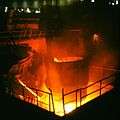Toledo steel
Toledo steel, known historically as unusually hard, is from Toledo, Spain, which has been a traditional sword-making, steel-working center since about 500 BC, and came to the attention of Rome when used by Hannibal in the Punic Wars. Soon, it became a standard source of weaponry for Roman legions.[1]
Toledo steel was famed for its very high quality alloy,[2] whereas Damascus steel, a competitor from the Middle Ages onward, was famed for a specific metal-working technique.[3]
History
The Iberian peninsula had been known since pre-Roman times for the high quality of swords originating from this region, which related to their manufacture, design, and ergonomics. Models such as the Iberian Falcata (a short sword), or the Gladius Hispaniensis (a Roman short sword), were used by the Carthaginian and Roman troops from the times of the Second Punic War (2nd and 3rd Centuries B.C.). In subsequent periods of time, this short sword became one of the standard armaments of the Roman legions.[4][5]
References
- ↑ "History of Swords from Toledo". swordsfromtoledo.com.
- ↑ "Damascene Technique in Metal Working". uni-kiel.de.
- ↑ "Toledo swords, sabers and medieval armours". www.aceros-de-hispania.com. Retrieved 2015-07-06.
- ↑ Christian Dietz. "Metallographic investigation of a Toledo-steel sword". academia.edu.
- ↑ "Marto Swords". swordsandsabers.com.
